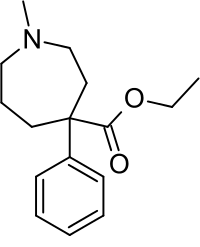Ethoheptazine
Ethoheptazine[1] (trade name Zactane) is an opioid analgesic from the phenazepine family. It was invented in the 1950s[2] and is related to other drugs such as proheptazine and pethidine.[3]
Ethoheptazine produces similar effects to other opioids, including analgesia, sedation, dizziness and nausea.[4] It was sold by itself as Zactane, and is still available as a combination product with acetylsalicylic acid and meprobamate as Equagesic, which is used for the treatment of conditions where both pain and anxiety are present.[5]
Its no longer sold in the United States however it may be sold again if the law is changed to remove the drug from the CSD.
References
- ↑ ES Patent 310184
- ↑ Batterman RC, Golbey M, Grossman AJ, Leifer P. Analgesic effectiveness of orally administered ethoheptazine in man. American Journal of Medical Sciences. 1957 Oct;234(4):413-9.
- ↑ Diamond J, Bruce WF, Tyson FT. Synthesis and Properties of the Analgesic DL-α-1,3-dimethyl-4-phenyl-4-propionoxyazacycloheptane (Proheptazine). Journal of Medicinal Chemistry. 1964 Jan;7:57-60.
- ↑ Cinelli P, Zucchini M. Current pharmaco-therapeutic possibilities in the treatment of pain. Experiments with ethoeptazine. (Italian). Minerva Medica. 1962 Mar 3;53:637-42.
- ↑ Scheiner JJ, Richards DJ. Treatment of musculoskeletal pain and associated anxiety with an ethoheptazine-aspirin-meprobamate combination (equagesic): a controlled study. Current Therapeutic Research, Clinical and Experimental. 1974 Sep;16(9):928-36.
|
|---|
| | Opioids | |
|---|
| | Anilines | |
|---|
| | NSAIDs | |
|---|
| | Cannabinoids | |
|---|
| | Channelergics | |
|---|
| | Myorelaxants | |
|---|
| | Others | |
|---|
| |
| | |
|---|
| | Description |
- Anatomy
- meninges
- cortex
- association fibers
- commissural fibers
- lateral ventricles
- basal ganglia
- diencephalon
- mesencephalon
- pons
- cerebellum
- medulla
- spinal cord
- Physiology
- Development
|
|---|
| | Disease |
- Cerebral palsy
- Meningitis
- Demyelinating diseases
- Seizures and epilepsy
- Headache
- Stroke
- Sleep
- Congenital
- Injury
- Neoplasms and cancer
- Other
- Symptoms and signs
- head and neck
- eponymous
- lesions
- Tests
|
|---|
| | Treatment |
- Procedures
- Drugs
- general anesthetics
- analgesics
- addiction
- epilepsy
- cholinergics
- migraine
- Parkinson's
- vertigo
- other
|
|---|
|
|
|
|---|
| Receptor
(ligands) | | MOR |
- PAMs: BMS-986121
- BMS-986122
|
|---|
| | DOR | |
|---|
| | KOR |
- Agonists: 6'-GNTI
- 8-CAC
- 18-MC
- 14-Methoxymetopon
- β-Chlornaltrexamine
- β-Funaltrexamine
- Adrenorphin (metorphamide)
- Akuuamicine
- Alazocine
- Allomatrine
- Asimadoline
- BAM-12P
- BAM-18P
- BAM-22P
- Big dynorphin
- Bremazocine
- BRL-52537
- Butorphanol
- BW-373U86
- Cebranopadol
- Ciprefadol
- CR845
- Cyclazocine
- Cyclorphan
- Cyprenorphine
- Diamorphine (heroin)
- Diacetylnalorphine
- Dihydroetorphine
- Dihydromorphine
- Dynorphin A
- Dynorphin B (rimorphin)
- Enadoline
- Eptazocine
- Erinacine E
- Ethylketazocine
- Etorphine
- FE 200665 (CR665)
- Fedotozine
- Fentanyl
- Gemazocine
- GR-89696
- GR-103545
- Hemorphin-4
- Herkinorin
- HS665
- Hydromorphone
- HZ-2
- Ibogaine
- ICI-199,441
- ICI-204,448
- Ketamine
- Ketazocine
- Laudanosine
- Leumorphin (dynorphin B-29)
- Levallorphan
- Levorphanol
- Lofentanil
- LPK-26
- Lufuradom
- Matrine
- MB-1C-OH
- Menthol
- Metazocine
- Metkefamide
- Mianserin
- Mirtazapine
- Morphine
- Moxazocine
- N-MPPP
- Nalbuphine
- NalBzOH
- Nalfurafine
- Nalmefene
- Nalorphine
- Naltriben
- Norbuprenorphine
- Norbuprenorphine-3-glucuronide
- O-Desmethyltramadol
- Oripavine
- Oxilorphan
- Oxycodone
- Pentazocine
- Pethidine (meperidine)
- Phenazocine
- Proxorphan
- RB-64
- Salvinorin A (salvia)
- Salvinorin B ethoxymethyl ether
- Salvinorin B methoxymethyl ether
- SKF-10047
- Spiradoline (U-62,066)
- Thienorphine
- Tifluadom
- Tricyclic antidepressants (e.g., amitriptyline, desipramine, imipramine, nortriptyline)
- U-50,488
- U-54,494A
- U-69,593
- Xorphanol
|
|---|
| | NOP |
- Antagonists: (Nphe1)Nociceptin(1-13)NH2
- AT-076
- BAN-ORL-24
- J-113397
- JTC-801
- LY-2940094
- NalBzOH
- Nociceptin (1-7)
- Nocistatin
- SB-612111
- SR-16430
- Thienorphine
- Trap-101
- UFP-101
|
|---|
| Unsorted /
unknown | |
|---|
|
|---|
| Enzyme
(inhibitors) | |
|---|
| | Others | |
|---|
| See also: Neuropeptidergics • Peptidergics |
|
